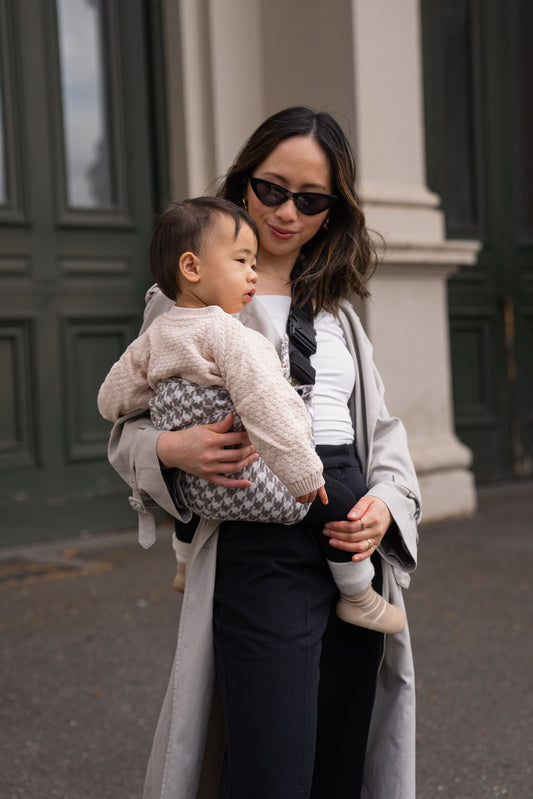SAFETY
Toddlerwearing offers numerous benefits, including bonding, and convenience. However, ensuring the safety of your child while wearing our Cuddl carrier is paramount.
Always follow the below:
- Follow the TICKS* rule for child safety:
- Tight
- In view at all times
- Close enough to kiss
- Keep chin off chest
- Supported back
- carrier serves as support, always hold child with at least one hand
- adjust child to sit close to body
- sit child so that knees are bent and positioned slightly higher than hips in “M” position
- balance may be affected, take extra care when leaning or walking
- never bend at waist; bend at knees and ensure to hold onto your child when bending so they don’t fall out of the carrier
- don’t use carrier during activities that could lead to injury, such as around heat source or exposure to chemicals
regularly check your child as they can be in distress without making any noise or movement. - before each use, ensure buckle is secure
- stop using carrier if parts are missing or damaged
- look for ripped seams, torn straps and damaged buckle
- key ring is removable and can be a choking hazard, do not leave carrier with child unattended
- be aware your activity may loosen the carrier, ensure to monitor every so often and adjust accordingly
- only use carrier with children who can support their own neck and sit up right
- only used with infants from 9 months up to 4 years and max 20 kg
*The TICKS rule for baby carrier safety
Tight
The carrier should be tight with your child positioned high and upright with head support. Any loose fabric may cause your baby to slump down, restricting its breathing.
In view at all times
You should always be able to see your baby’s face by simply looking down.
Ensure your child’s face, nose and mouth remain uncovered by the carrier or your body
Close enough to kiss
Your child should be close enough that you can easily kiss them. This ensures that they are within a safe range for breathing and allows you to easily monitor their well-being.
Keep chin off chest
Ensure your child's airways is always clear. Their head should be positioned so they can breathe easily. Regularly check your child.
Supported back
Your child's back should be supported in a natural position, ensure to always have one arm around them.
When bending over, support your child with one hand behind its back and bend at the knees, not at the waist.
Shop our Classic Collection
-

 Sold out
Sold outGrey Houndstooth Toddler Carrier
Regular price $119.95 AUDRegular priceUnit price / per -
Sand Toddler Carrier
Regular price $119.95 AUDRegular priceUnit price / per -
Black Toddler Carrier
Regular price $119.95 AUDRegular priceUnit price / per






